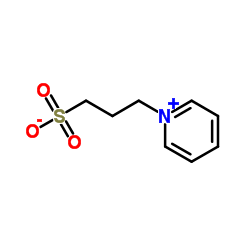3-(1-Pyridinio)-1-propanesulfonate

3-(1-Pyridinio)-1-propanesulfonate structure
|
Common Name | 3-(1-Pyridinio)-1-propanesulfonate | ||
|---|---|---|---|---|
| CAS Number | 15471-17-7 | Molecular Weight | 201.243 | |
| Density | N/A | Boiling Point | N/A | |
| Molecular Formula | C8H11NO3S | Melting Point | 280ºC | |
| MSDS | Chinese USA | Flash Point | 160ºC | |
|
Near IR fluorescent conjugated poly(ethylene glycol)bisphosphonate nanoparticles for in vivo bone targeting in a young mouse model.
J. Nanobiotechnology 13 , 80, (2015) Bisphosphonate (BP) compounds are widely used in the treatment of bone disorders. This group of drugs with a high affinity to Ca(+2) ions is rapidly attracted to bone mineral, especially in areas of high resorption. We have engineered unique biodegradable BP ... |
|
|
Enrichment and Analysis of Intact Phosphoproteins in Arabidopsis Seedlings.
PLoS ONE 10 , e0130763, (2015) Protein phosphorylation regulates diverse cellular functions and plays a key role in the early development of plants. To complement and expand upon previous investigations of protein phosphorylation in Arabidopsis seedlings we used an alternative approach tha... |
|
|
Conjugate-like immunogens produced as protein capsular matrix vaccines.
Proc. Natl. Acad. Sci. U. S. A. 112(10) , E1143-51, (2015) Capsular polysaccharides are the primary antigenic components involved in protective immunity against encapsulated bacterial pathogens. Although immunization of adolescents and adults with polysaccharide antigens has reduced pathogen disease burden, pure poly... |
|
|
Characterization of the Bacterial Community Naturally Present on Commercially Grown Basil Leaves: Evaluation of Sample Preparation Prior to Culture-Independent Techniques.
Int. J. Environ. Res. Public Health 12 , 10171-97, (2015) Fresh herbs such as basil constitute an important food commodity worldwide. Basil provides considerable culinary and health benefits, but has also been implicated in foodborne illnesses. The naturally occurring bacterial community on basil leaves is currently... |
|
|
Engineering the genome of Thermus thermophilus using a counterselectable marker.
J. Bacteriol. 197(6) , 1135-44, (2015) Thermus thermophilus is an extremely thermophilic bacterium that is widely used as a model thermophile, in large part due to its amenability to genetic manipulation. Here we describe a system for the introduction of genomic point mutations or deletions using ... |
|
|
Microbiological analysis of pre-packed sweet basil (Ocimum basilicum) and coriander (Coriandrum sativum) leaves for the presence of Salmonella spp. and Shiga toxin-producing E. coli.
Int. J. Food Microbiol. 208 , 11-8, (2015) Enteric pathogens, such as Salmonella spp. and pathogenic Escherichia coli, have been detected and associated with food borne outbreaks from (imported) fresh leafy herbs. Screening on imported herbs from South East Asian countries has been described. However,... |
|
|
Microbial safety and sanitary quality of strawberry primary production in Belgium: risk factors for Salmonella and Shiga toxin-producing Escherichia coli contamination.
Appl. Environ. Microbiol. 81(7) , 2562-70, (2015) Strawberries are an important fruit in Belgium in both production and consumption, but little information is available about the presence of Salmonella and Shiga toxin-producing Escherichia coli (STEC) in these berries, the risk factors in agricultural produc... |
|
|
Biomarker discovery: quantification of microRNAs and other small non-coding RNAs using next generation sequencing.
BMC Med. Genomics 8 , 35, (2015) Small ncRNAs (sncRNAs) offer great hope as biomarkers of disease and response to treatment. This has been highlighted in the context of several medical conditions such as cancer, liver disease, cardiovascular disease, and central nervous system disorders, amo... |
|
|
Bovine immunoglobulin/protein isolate binds pro-inflammatory bacterial compounds and prevents immune activation in an intestinal co-culture model.
PLoS ONE 10(4) , e0120278, (2015) Intestinal barrier dysfunction is associated with chronic gastrointestinal tract inflammation and diseases such as IBD and IBS. Serum-derived bovine immunoglobulin/protein isolate (SBI) is a specially formulated protein preparation (>90%) for oral administrat... |
|
|
C4 Deficiency is a predisposing factor for Streptococcus pneumoniae-induced autoantibody production.
J. Immunol. 193(11) , 5434-43, (2014) Reductions in C4 levels may predispose individuals to infection with encapsulated bacteria as well as autoimmunity. In this study, we examined the role C4 has in protection against Streptococcus pneumoniae-induced autoimmunity. Mild respiratory infection with... |